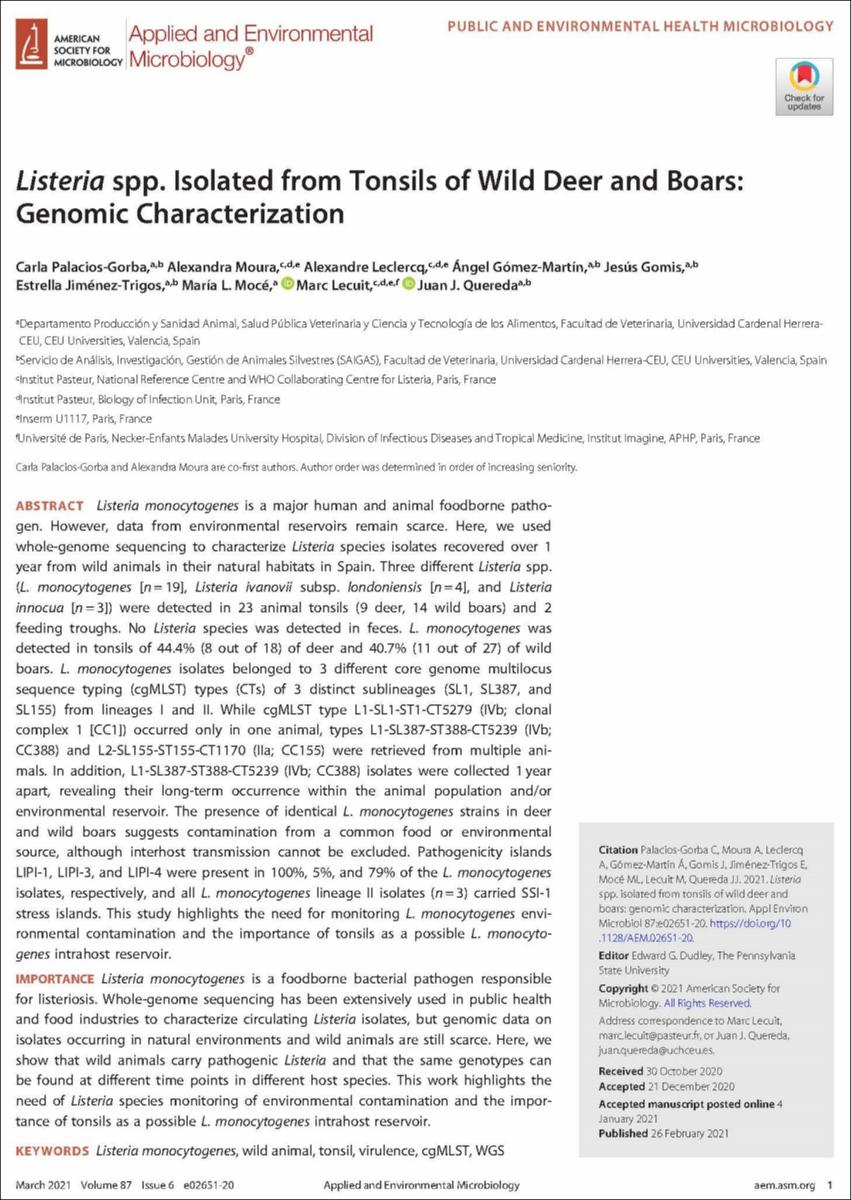Por favor, use este identificador para citar o enlazar este ítem:
http://hdl.handle.net/10637/16121"Listeria spp." isolated from tonsils of wild deer and boars: genomic characterization

Ver/Abrir:
Listeria_Palacios_AEM_2021.jpg
799,36 kB
JPEG
Ver/Abrir:
Listeria_Palacios_AEM_2021.pdf
Acceso restringido
695,26 kB
Adobe PDF
Request a copy
| Título : | "Listeria spp." isolated from tonsils of wild deer and boars: genomic characterization |
| Autor : | Palacios Gorba, Carla Moura, Alexandra Leclercq, Alexandre Gómez Martín, Ángel Gomis Almendro, Jesús Jiménez Trigos, Estrella Mocé Cervera, María Lecuit, Marc Quereda Torres, Juan José |
| Materias: | Listeria; Listeriosis; Enfermedad animal; Animal diseases; Zoonosis; Zoonoses; Animal salvaje; Wild animals; Genética animal; Animal genetics |
| Editorial : | American Society for Microbiology (ASM) |
| Citación : | Palacios-Gorba, C., Moura, A., Leclercq, A., Gómez-Martín, Á., Gomis, J., Jiménez-Trigos, E., Mocé, M.L., Lecuit, M. & Quereda, J.J. (2021). "Listeria spp." isolated from tonsils of wild deer and boars: genomic characterization. Applied and Environmental Microbiology, vol. 87, i. 6 (feb.), art. e02651-20. DOI: https://doi.org/10.1128/AEM.02651-20 |
| Resumen : | Listeria monocytogenes is a major human and animal foodborne patho-gen. However, data from environmental reservoirs remain scarce. Here, we usedwhole-genome sequencing to characterize Listeria species isolates recovered over 1year from wild animals in their natural habitats in Spain. Three different Listeria spp.(L. monocytogenes [n = 19], Listeria ivanovii subsp. londoniensis [n = 4], and Listeriainnocua [n = 3]) were detected in 23 animal tonsils (9 deer, 14 wild boars) and 2feeding troughs. No Listeria species was detected in feces. L. monocytogenes wasdetected in tonsils of 44.4% (8 out of 18) of deer and 40.7% (11 out of 27) of wildboars. L. monocytogenes isolates belonged to 3 different core genome multilocussequence typing (cgMLST) types (CTs) of 3 distinct sublineages (SL1, SL387, andSL155) from lineages I and II. While cgMLST type L1-SL1-ST1-CT5279 (IVb; clonalcomplex 1 [CC1]) occurred only in one animal, types L1-SL387-ST388-CT5239 (IVb;CC388) and L2-SL155-ST155-CT1170 (IIa; CC155) were retrieved from multiple ani-mals. In addition, L1-SL387-ST388-CT5239 (IVb; CC388) isolates were collected 1 yearapart, revealing their long-term occurrence within the animal population and/orenvironmental reservoir. The presence of identical L. monocytogenes strains in deerand wild boars suggests contamination from a common food or environmentalsource, although interhost transmission cannot be excluded. Pathogenicity islandsLIPI-1, LIPI-3, and LIPI-4 were present in 100%, 5%, and 79% of the L. monocytogenesisolates, respectively, and all L. monocytogenes lineage II isolates (n = 3) carried SSI-1stress islands. This study highlights the need for monitoring L. monocytogenes envi-ronmental contamination and the importance of tonsils as a possible L. monocyto-genes intrahost reservoir. |
| Descripción : | Este recurso no está disponible en acceso abierto por política de la editorial. |
| URI : | http://hdl.handle.net/10637/16121 |
| Derechos: | http://creativecommons.org/licenses/by-nc-nd/4.0/deed.es |
| ISSN : | 0099-2240 1098-5336 (Electrónico) |
| Fecha de publicación : | 26-feb-2021 |
| Centro : | Universidad Cardenal Herrera-CEU |
| Aparece en las colecciones: | Dpto. Producción y Sanidad Animal, Salud Pública Veterinaria y Ciencia y Tecnología de los Alimentos |
Los ítems de DSpace están protegidos por copyright, con todos los derechos reservados, a menos que se indique lo contrario.

